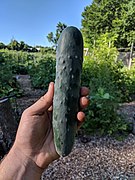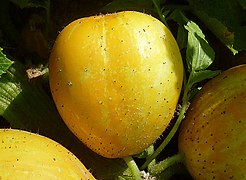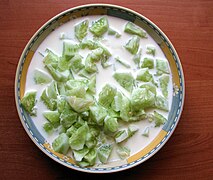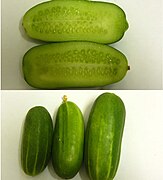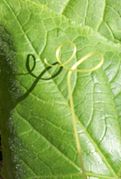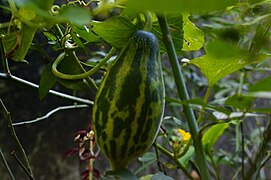Cucumber
| Cucumber | |
|---|---|
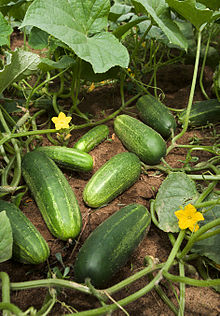
| |
| Cucumbers growing on vines | |

| |
| A single cucumber fruit | |
| Scientific classification | |
| Kingdom: | Plantae |
| Clade: | Tracheophytes |
| Clade: | Angiosperms |
| Clade: | Eudicots |
| Clade: | Rosids |
| Order: | Cucurbitales |
| Family: | Cucurbitaceae |
| Genus: | Cucumis |
| Species: | C. sativus
|
| Binomial name | |
| Cucumis sativus | |
Thecucumber(Cucumis sativus) is a widely-cultivatedcreeping vineplant in the familyCucurbitaceaethat bears cylindrical to sphericalfruits,which are used asculinary vegetables.[1]Considered an annual plant,[2]there are three main types of cucumber—slicing,pickling,andseedless—within which severalcultivarshave been created. The cucumber originates inAsiaextending fromIndia,Nepal,Bangladesh,China(Yunnan,Guizhou,Guangxi), andNorthern Thailand,[3][4][5][6]but now grows on mostcontinents,and many different types of cucumber are grown commercially and traded on theglobal market.InNorth America,the termwild cucumberrefers to plants in thegeneraEchinocystisandMarah,though the two are not closely related.
Description
The cucumber is acreeping vinethat roots in the ground and grows uptrellisesor other supporting frames, wrapping around supports with thin, spiralingtendrils.[7]The plant may also root in asoilless medium,whereby it will sprawl along the ground in lieu of a supporting structure. The vine has large leaves that form acanopyover the fruits.[citation needed]
The fruit of typical cultivars of cucumber is roughlycylindrical,but elongated with tapered ends, and may be as large as 62 centimeters (24 in) long and 10 centimeters (4 in) in diameter.[8]
Cucumber fruits consist of 95% water (see nutrition table). Inbotanicalterms, the cucumber is classified as apepo,a type ofbotanical berrywith a hard outer rind and no internal divisions. However, much liketomatoesandsquashes,it is often perceived, prepared, and eaten as avegetable.[9]
Flowering and pollination

| NCBIgenome ID | 1639 |
|---|---|
| Ploidy | diploid |
| Genome size | 323.99 Mb |
| Sequencedorganelle | mitochondrion |
| Organelle size | 244.82 Mb |
| Year ofcompletion | 2011 |
Most cucumber cultivars are seeded and require pollination. For this purpose, thousands ofhoneybeehivesare annually carried to cucumber fields just before bloom. Cucumbers may also be pollinated viabumblebeesand several other bee species. Most cucumbers that require pollination areself-incompatible,thus requiring thepollenof another plant in order to formseedsand fruit.[10]Some self-compatible cultivars exist that are related to the 'Lemon cucumber' cultivar.[10]
A fewcultivarsof cucumber areparthenocarpic,theblossomsof which createseedless fruitwithoutpollination,which degrades the eating quality of these cultivar. In theUnited States,these are usually grown ingreenhouses,wherebeesare excluded. InEurope,they are grown outdoors in some regions, where bees are likewise excluded.[citation needed]
Traditional cultivars produce male blossoms first, then female, in about equivalent numbers. Newergynoecioushybrid cultivars produce almost all female blossoms. They may have apollenizercultivar interplanted, and the number of beehives per unit area is increased, but temperature changes induce male flowers even on these plants, which may be sufficient for pollination to occur.[10]
In 2009, an international team of researchers announced they had sequenced the cucumbergenome.[11]
A study ofgenetic recombinationduringmeiosisin cucumber provided a high resolution landscape of meioticDNA double strand-breaksandgenetic crossovers.[12]The average number of crossovers per chromosome per meiosis was 0.92 to 0.99.[12]
Herbivore defense
Phytochemicalsin cucumbers may discourage naturalforagingbyherbivores,such as insects,nematodesorwildlife.[13]As a possible defense mechanism, cucumbers producecucurbitacin C,[14]which causes abitter tastein some cucumber varieties. This potential mechanism is under preliminary research to identify whether cucumbers are able to deter herbivores andenvironmental stressesby using an intrinsicchemical defense,particularly in the leaves,cotyledons,pedicel,carpopodium,and fruit.[14][15]
Nutrition, aroma, and taste
| Nutritional value per 100 g (3.5 oz) | |
|---|---|
| Energy | 65 kJ (16 kcal) |
3.63 g | |
| Sugars | 1.67 |
| Dietary fiber | 0.5 g |
0.11 g | |
0.65 g | |
| Vitamins | Quantity %DV† |
| Thiamine (B1) | 2% 0.027 mg |
| Riboflavin (B2) | 3% 0.033 mg |
| Niacin (B3) | 1% 0.098 mg |
| Pantothenic acid (B5) | 5% 0.259 mg |
| Vitamin B6 | 2% 0.04 mg |
| Folate (B9) | 2% 7 μg |
| Vitamin C | 3% 2.8 mg |
| Vitamin K | 14% 16.4 μg |
| Minerals | Quantity %DV† |
| Calcium | 1% 16 mg |
| Iron | 2% 0.28 mg |
| Magnesium | 3% 13 mg |
| Manganese | 3% 0.079 mg |
| Phosphorus | 2% 24 mg |
| Potassium | 5% 147 mg |
| Sodium | 0% 2 mg |
| Zinc | 2% 0.2 mg |
| Other constituents | Quantity |
| Water | 95.23 g |
| †Percentages estimated usingUS recommendationsfor adults,[16]except for potassium, which is estimated based on expert recommendation fromthe National Academies.[17] | |
Raw cucumber (withpeel) is 95% water, 4%carbohydrates,1%protein,and contains negligiblefat.A100-gram (3+1⁄2-ounce)reference servingprovides 65 kilojoules (16 kilocalories) offood energy.It has a low content ofmicronutrients:it is notable only forvitamin K,at 14% of theDaily Value(table).
Depending on variety, cucumbers may have a mildmelonaroma and flavor, in part resulting from unsaturatedaldehydes,such as(E,Z)-nona-2,6-dienal,and thecis- andtrans-isomersof2-nonenal.[18]The slightlybittertaste of cucumber rind results fromcucurbitacins.[19]
Varieties
In generalcultivation,cucumbers are classified into three maincultivargroups: slicing,pickled,andseedless/burpless.
Uses
Culinary
Slicing
Cucumbers grown to eat fresh are calledslicing cucumbers.The main varieties of slicers mature onvineswith large leaves that provide shading.[20]
Slicers grown commercially for the North American market are generally longer, smoother, more uniform in color, and have much tougher skin. In contrast, those in other countries, often calledEuropean cucumbers,are smaller and have thinner, more delicate skin, often with fewer seeds, thus are often sold in plastic skin for protection. This variety may also be called atelegraph cucumber,particularly inAustralasia.[21]
Pickling
Picklingwithbrine,sugar,vinegar,and spices creates various flavored products from cucumbers and other foods.[22]Although any cucumber can be pickled, commercial pickles are made from cucumbers specially bred for uniformity of length-to-diameter ratio and lack of voids in the flesh. Those cucumbers intended for pickling, calledpicklers,grow to about 7 to 10 cm (3 to 4 in) long and 2.5 cm (1 in) wide. Compared to slicers, picklers tend to be shorter, thicker, less-regularly shaped, and have bumpy skin with tiny white or black-dotted spines. Color can vary from creamy yellow to pale or dark green.[citation needed]
Gherkin
Gherkins,also calledcornichons,[23]orbaby pickles,are small cucumbers, typically those 2.5 to 12.5 centimetres (1 to 5 in) in length, often with bumpy skin, which are typically used for pickling.[24][25][26]The wordgherkincomes from the early modernDutchgurkenoraugurken('small pickled cucumber').[27]The term is also used in the name forCucumis anguria,theWest Indian gherkin,a closely related species.[28]
Burpless
Burpless cucumbers are sweeter and have a thinner skin than other varieties of cucumber. They are reputed to be easy to digest and to have a pleasant taste. They can grow as long as 60 centimeters (2 ft), are nearly seedless, and have a delicate skin. Most commonly grown in greenhouses, theseparthenocarpiccucumbers are often found ingrocery markets,shrink-wrappedin plastic. They are marketed as either burpless or seedless, as the seeds and skin of other varieties of cucumbers are said to give some people gas.[29]
Production
| Cucumber production – 2022 | |
|---|---|
| Country | millions oftonnes |
| 77.3 | |
| 1.9 | |
| 1.6 | |
| 1.1 | |
| World | 94.7 |
| Source:FAOSTATof theUnited Nations[30] | |
In 2022, world production of cucumbers and gherkins was 95 milliontonnes,led by China with 82% of the total.[30]
Cultivation history
Cultivated for at least 3,000 years, the cultivated cucumbers"Cucumis sativus"were domesticated inIndiafrom wild "C. sativus var. hardwickii".[31][32][33]where a great many varieties have been observed, along with its closest living relative,Cucumis hystrix.[34]Three main cultivar groups of cucumber are namely Eurasian cucumbers (slicing cucumbers eaten raw and immature), East Asian cucumbers (pickling cucumbers) and Xishuangbanna cucumbers. Based on demographic modelling, the East Asian C. sativus cultivars diverged from the Indian cultivars c. 2500 years ago.[35]It was probably introduced to Europe by theGreeksorRomans.Records of cucumber cultivation appear inFrancein the 9th century,Englandin the 14th century, and in North America by the mid-16th century.[1][36][37][38]
Roman Empire
According toPliny the Elder,the EmperorTiberiushad the cucumber on his table daily during summer and winter. In order to have it available for his table every day of the year, the Romans reportedly used artificial methods of growing (similar to thegreenhouse system), wherebymirrorstonerefers to Pliny'slapis specularis,believed to have been sheetmica:[39][40]
Indeed, he was never without it; for he had raised beds made in frames upon wheels, by means of which the cucumbers were moved and exposed to the full heat of the sun; while, in winter, they were withdrawn, and placed under the protection of frames glazed with mirrorstone.
— Pliny the Elder,Natural HistoryXIX.xxiii, "Vegetables of a Cartilaginous Nature—Cucumbers. Pepones"
Reportedly, they were also cultivated inspecularia,cucumber houses glazed with oiled cloth.[39]Pliny describes the Italian fruit as very small, probably like agherkin.He also describes the preparation of a medication known aselaterium.However, some scholars[who?]believe that he was instead referring toEcballium elaterium,known in pre-Linneantimes asCucumis silvestrisorCucumis asininus('wild cucumber' or 'donkey cucumber'), a species different from the common cucumber.[41]Pliny also writes about several other varieties of cucumber, including the cultivated cucumber,[42]and remedies from the different types (9 from the cultivated; 5 from the "anguine;" and 26 from the "wild" ).
Middle Ages
Charlemagnehad cucumbers grown in his gardens in the 8th/9th century. They were reportedly introduced into England in the early 14th century, lost, then reintroduced approximately 250 years later. TheSpaniards(through theItalianChristopher Columbus) brought cucumbers toHaitiin 1494. In 1535,Jacques Cartier,a French explorer, found "very great cucumbers" grown on the site of what is nowMontreal.[citation needed]
Early-modern age

Throughout the 16th century, European trappers, traders,bisonhunters, and explorers bartered for the products of American Indianagriculture.The tribes of theGreat Plainsand theRocky Mountainslearned from the Spanish how to grow European crops. The farmers on the Great Plains included theMandanandAbenaki.They obtained cucumbers andwatermelonsfrom the Spanish, and added them to the crops they were already growing, including several varieties ofcornandbeans,pumpkins,squash,andgourdplants.[43]TheIroquoiswere also growing them when the first Europeans visited them.[44]
In 1630, the ReverendFrancis Higginsonproduced a book calledNew-Englands Plantationin which, describing a garden on Conant's Island inBoston Harborknown asThe Governor's Garden,he states:[45]
The countrie aboundeth naturally with store of roots of great varietie [sic] and good to eat. Our turnips, parsnips, and carrots are here both bigger and sweeter than is ordinary to be found in England. Here are store of pompions, cowcumbers, and other things of that nature which I know not...
InNew England Prospect(1633, England), William Wood published observations he made in 1629 in America:[46]
The ground affords very good kitchin gardens, for Turneps, Parsnips, Carrots, Radishes, and Pompions, Muskmillons, Isquoter-squashes, coucumbars, Onyons, and whatever grows well in England grows as well there, many things being better and larger. [sic]
Age of Enlightenment and later

In the later 17th century, a prejudice developed against uncooked vegetables and fruits. A number of articles in contemporary health publications stated that uncooked plants brought on summer diseases and should be forbidden to children. The cucumber kept this reputation for an inordinate period of time, "fit only for consumption by cows," which some believe is why it gained the name,cowcumber.[citation needed]
Samuel Pepyswrote in his diary on 22 August 1663:[47]
[T]his day Sir W. Batten tells me that Mr. Newburne is dead of eating cowcumbers, of which the other day I heard of another, I think.
John Evelyn in 1699 wrote that the cucumber, 'however dress'd, was thought fit to be thrown away, being accounted little better than poyson (poison)'.[48][49]
According to 18th-century British writerSamuel Johnson,it was commonly said among English physicians that a cucumber "should be well sliced, and dressed with pepper and vinegar, and then thrown out, as good for nothing."[50]
A copperetchingmade by Maddalena Bouchard between 1772 and 1793 shows this plant to have smaller, almost bean-shaped fruits, and small yellow flowers. The small form of the cucumber is figured inHerbalsof the 16th century, however stating that "[i]f hung in a tube while in blossom, the Cucumber will grow to a most surprising length."[citation needed]
Gallery
-
Salad cucumber
-
An Indian yellow cucumber
-
A Scandinavian cucumber in slices
-
Grated cucumber
-
Komkommer (Cucumis sativus'Gele Tros')
-
A varietal grown by theHmong peoplewith textured skin and large seeds
-
Lemon cucumber
-
Dish with cucumber cut pieces (mizeria)
-
Pickling cucumbers
-
Gherkins
-
Leaves
-
Atendrilemerges from cucumber vines to facilitate climbing
-
A stringlatticesupports vine growth
See also
- Armenian cucumber,a variety ofmelonthat resembles a cucumber
- Cucumber blessing
- Cucumber cake
- Cucumber juice
- Cucumber raita
- Cucumber sandwich
- Cucumber soda
- Cucumber soup
- Sea cucumber,named for its resemblance to the fruit
References
- ^ab"Cucumber."Encyclopædia Britannica.[1998] 2019.
- ^Silvertown, Jonathan (1985). "Survival, Fecundity and Growth of Wild Cucumber, Echinocystis Lobata".Journal of Ecology.73(3): 841–849.doi:10.2307/2260151.JSTOR2260151.
- ^Chomicki, Guillaume; Schaefer, Hanno; Renner, Susanne S. (June 2020)."Origin and domestication of Cucurbitaceae crops: insights from phylogenies, genomics and archaeology".New Phytologist.226(5): 1240–1255.doi:10.1111/nph.16015.
- ^Weng, Yiqun (7 January 2021)."Cucumis sativus Chromosome Evolution, Domestication, and Genetic Diversity: Implications for Cucumber Breeding".Plant Breeding Reviews.Wiley: 79–111.doi:10.1002/9781119717003.ch4.
- ^"Cucumis sativusL. "Plants of the World Online.Royal Botanic Gardens, Kew.Retrieved23 February2023.
- ^Bisht, I. S.; Bhat, K.V.; Tanwar, S. P. S.; Bhandari, D. C.; Joshi, Kamal; Sharma, A. K. (January 2004)."Distribution and genetic diversity of Cucumis sativus var. hardwickii (Royle) Alef in India".The Journal of Horticultural Science and Biotechnology.79(5): 783–791.doi:10.1080/14620316.2004.11511843.ISSN1462-0316.
- ^Mariod, Abdalbasit Adam; Mirghani, Mohamed Elwathig Saeed; Hussein, Ismail Hassan (14 April 2017).Cucumis sativus,Cucumber; Chapter 16 in: Unconventional Oilseeds and Oil Sources.Academic Press.ISBN9780128134337.
- ^Zhang, Tingting; Li, Xvzhen; Yang, Yuting; Guo, Xiao; Feng, Qin; Dong, Xiangyu; Chen, Shuxia (2019). "Genetic analysis and QTL mapping of fruit length and diameter in a cucumber (Cucumber sativusL.) recombinant inbred line (RIL) population ".Scientia Horticulturae.250:214–222.doi:10.1016/j.scienta.2019.01.062.S2CID92837522.
- ^"Cucumber".Fruit or Vegetable?.Retrieved5 December2019.
- ^abcNonnecke, I.L. (1989).Vegetable Production.Springer.ISBN9780442267216.
- ^Huang, S.; Li, R.; Zhang, Z.; Li, L.; et al. (2009)."The genome of the cucumber,Cucumis sativusL ".Nature Genetics.41(12): 1275–81.doi:10.1038/ng.475.PMID19881527.
- ^abWang Y, Dong Z, Ma Y, Zheng Y, Huang S, Yang X (October 2023)."Comprehensive dissection of meiotic DNA double-strand breaks and crossovers in cucumber".Plant Physiol.193(3): 1913–1932.doi:10.1093/plphys/kiad432.PMC10602612.PMID37530486.
- ^Shang Y, Ma Y, Zhou Y, et al. (November 2014). "Plant science. Biosynthesis, regulation, and domestication of bitterness in cucumber".Science.346(6213): 1084–8.Bibcode:2014Sci...346.1084S.doi:10.1126/science.1259215.PMID25430763.S2CID206561241.
- ^abLiu, Zhiqiang; Li, Yawen; Cao, Chunyu; Liang, Shan; Ma, Yongshuo; Liu, Xin; Pei, Yanxi (February 2019). "The role of H2S in low temperature-induced cucurbitacin C increases in cucumber".Plant Molecular Biology.99(6): 535–544.doi:10.1007/s11103-019-00834-w.PMID30707394.S2CID73431225.
- ^He, Jun (2022)."Terpene Synthases in Cucumber (Cucumis sativus) and Their Contribution to Herbivore-induced Volatile Terpenoid Emission".New Phytologist.233(2): 862–877.doi:10.1111/nph.17814.hdl:11245.1/e4b87361-6747-409a-a897-0e3939f560c0.PMC9299122.PMID34668204.S2CID239035917.
- ^United States Food and Drug Administration(2024)."Daily Value on the Nutrition and Supplement Facts Labels".FDA.Archivedfrom the original on 27 March 2024.Retrieved28 March2024.
- ^National Academies of Sciences, Engineering, and Medicine; Health and Medicine Division; Food and Nutrition Board; Committee to Review the Dietary Reference Intakes for Sodium and Potassium (2019). Oria, Maria; Harrison, Meghan; Stallings, Virginia A. (eds.).Dietary Reference Intakes for Sodium and Potassium.The National Academies Collection: Reports funded by National Institutes of Health. Washington, DC: National Academies Press (US).ISBN978-0-309-48834-1.PMID30844154.Archivedfrom the original on 9 May 2024.Retrieved21 June2024.
- ^Schieberle, P.; Ofner, S.; Grosch, W. (1990). "Evaluation of Potent Odorants in Cucumbers (Cucumis sativus) and Muskmelons (Cucumis melo) by Aroma Extract Dilution Analysis ".Journal of Food Science.55:193–195.doi:10.1111/j.1365-2621.1990.tb06050.x.
- ^Shang, Y; Ma, Y; Zhou, Y; Zhang, H; Duan, L; Chen, H; Zeng, J; Zhou, Q; Wang, S; Gu, W; Liu, M; Ren, J; Gu, X; Zhang, S; Wang, Y; Yasukawa, K; Bouwmeester, H. J.; Qi, X; Zhang, Z; Lucas, W. J.; Huang, S (2014). "Plant science. Biosynthesis, regulation, and domestication of bitterness in cucumber".Science.346(6213): 1084–8.Bibcode:2014Sci...346.1084S.doi:10.1126/science.1259215.PMID25430763.S2CID206561241.
- ^"Cucumbers: Planting, growing, and harvesting cucumbers".Old Farmer's Almanac, Yankee Publishing, Inc., Dublin, NH. 2016.Retrieved11 August2016.
- ^Cucumber – 5+ a day, New ZealandRetrieved 18 May 2018
- ^Avi, Torey (3 September 2014)."History in a jar: The story of pickles".Public Broadcasting Service.Retrieved13 November2017.
- ^"What's The Deal With Cornichons?".The Kitchn. 2017.Retrieved13 November2017.
- ^"Gherkins".Venlo, Netherlands: Zon. 2017. Archived fromthe originalon 14 November 2017.Retrieved13 November2017.
- ^"Cucumbers"(PDF).University of California-Davis: Western Institute for Food Safety and Security, US Department of Agriculture. May 2016.Retrieved13 November2017.
- ^"Cucumbers and gherkins".Agricultural and Processed Food Products Export Development Authority, Government of India. 2015.Retrieved13 November2017.
- ^"Word origin and history for gherkin".Dictionary.2017.Retrieved13 November2017.
- ^"West Indian gherkin,Cucumis anguriaL. "Plants for a Future. 2012.Retrieved13 November2017.
- ^Jordan-Reilly, Melissa (15 September 2013)."Why do cucumbers upset my digestion?".LiveStrong.
- ^ab"Cucumber and gherkin production in 2022, Crops/Regions/World list/Production Quantity/Year (pick lists)".UN Food and Agriculture Organization, Corporate Statistical Database (FAOSTAT). 2024.Retrieved10 June2024.
- ^Chomicki, Guillaume; Schaefer, Hanno; Renner, Susanne S. (June 2020)."Origin and domestication of Cucurbitaceae crops: insights from phylogenies, genomics and archaeology".New Phytologist.226(5): 1240–1255.doi:10.1111/nph.16015.
- ^Weng, Yiqun (7 January 2021)."Cucumis sativus Chromosome Evolution, Domestication, and Genetic Diversity: Implications for Cucumber Breeding".Plant Breeding Reviews.Wiley: 79–111.doi:10.1002/9781119717003.ch4.
- ^Bisht, I. S.; Bhat, K.V.; Tanwar, S. P. S.; Bhandari, D. C.; Joshi, Kamal; Sharma, A. K. (January 2004)."Distribution and genetic diversity of Cucumis sativus var. hardwickii (Royle) Alef in India".The Journal of Horticultural Science and Biotechnology.79(5): 783–791.doi:10.1080/14620316.2004.11511843.ISSN1462-0316.
- ^Asian News International.21 July 2010. "Cucumber, melon's common ancestor originated in Asia."NewsTrack India.Retrieved on 4 June 2020.
- ^Chomicki, Guillaume; Schaefer, Hanno; Renner, Susanne S. (June 2020)."Origin and domestication of Cucurbitaceae crops: insights from phylogenies, genomics and archaeology".New Phytologist.226(5): 1240–1255.doi:10.1111/nph.16015.ISSN0028-646X.
- ^Renner, SS; Schaefer, H; Kocyan, A (2007)."Phylogenetics ofCucumis(Cucurbitaceae): Cucumber (C. sativus) belongs in an Asian/Australian clade far from melon (C. melo) ".BMC Evolutionary Biology.7:58.doi:10.1186/1471-2148-7-58.PMC3225884.PMID17425784.
- ^Doijode, S. D. 2001.Seed storage of horticultural crops.Haworth Press.ISBN1-56022-901-2.p. 281.
- ^Zhuang, Fei-Yun; Chen, Jin-Feng; Staub, Jack E.; Qian, Chun-Tao (2006)."Taxonomic Relationships of A RareCucumisSpecies (C. hystrixChakr.) and Its Interspecific Hybrid with Cucumber ".HortScience.41(3): 571–574.doi:10.21273/HORTSCI.41.3.571.
- ^abJames, Peter J.; Thorpe, Nick; Thorpe, I. J. (1995). "Ch. 12, Sport and Leusure: Roman Gardening Technology".Ancient Inventions.Ballantine Books. p. 563.ISBN978-0-345-40102-1.
- ^Pliny the Elder.[77–79 AD] 1855. "Vegetables of a Cartilaginous Nature—Cucumbers. PeponesArchived5 June 2020 at theWayback Machine."Ch. 23 inThe Natural HistoryXIX, translated byJ. BostockandH. T. Riley.London:Taylor & Francis.– viaPerseus under PhiloLogic,alsoavailablevia Perseus Project.
- ^Pliny the Elder,Natural HistoryXX.iiiArchived5 June 2020 at theWayback Machine.
- ^Pliny the Elder,Natural HistoryXX.ivArchived5 June 2020 at theWayback Machine–vArchived5 June 2020 at theWayback Machine.
- ^Buchanan, David (2012).Taste, Memory: Forgotten Foods, Lost Flavors, and why They Matter.VT, USA: Chelsea Green Publishing. p. 109.ISBN9781603584401.
- ^Kuhnlein, H. V.;Turner, N. J. (1996).Traditional Plant Foods of Canadian Indigenous Peoples: Nutrition, Botany and Use.Amsterdam, Netherlands: Gordon and Breach. p. 159.ISBN9782881244650.
- ^Higginson, Francis.[1630] 1906.New-Englands Plantation.Salem, MA: Essex Book and Print Club.OCLC1049892552.p. 5.
- ^Wood, William. (1634). "Of the Hearbes, Fruites, Woods, Waters and Mineralls",pp. 13–18 inNew England Prospect.London.
- ^Saturday 22 August 1663 (Pepys' Diary).Pepysdiary. Retrieved on 25 November 2012.
- ^Evelyn, John (1699).Acetaria: A Discourse of Sallets.Prospect Books.ISBN978-0-907325-12-3.
- ^Davidson, Jan (15 July 2018).Pickles: A Global History (Edible).Reaktion Books.ISBN9781780239194.
{{cite book}}:CS1 maint: date and year (link) - ^Boswell, James (1832).The Life of Samuel Johnson: Including A Journal of a Tour to the Hebrides, Volumen 1.Carter, Hendee and Company. p. 423.Retrieved29 March2024.

